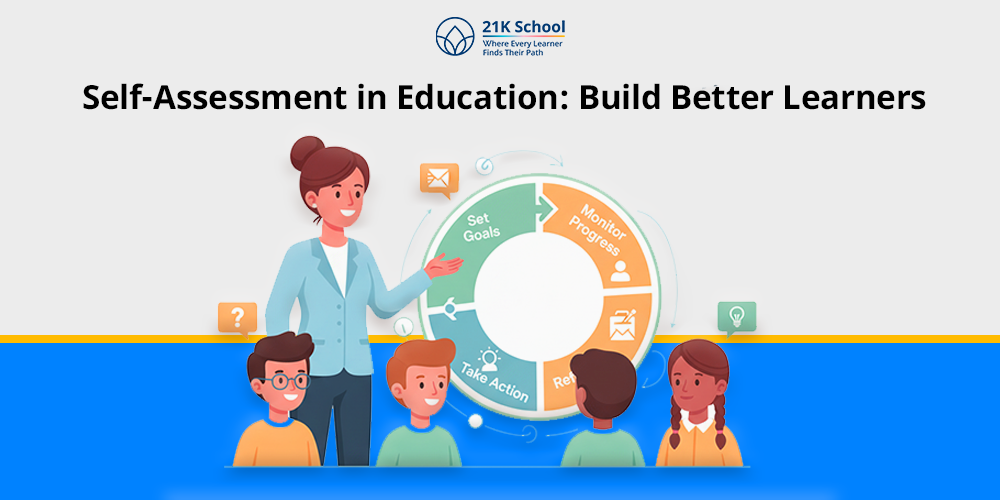
Learning is a key to success but in modern education using new and effective approaches offers remarkable benefits to learners.
Self-assessment in education is one of the ideal approaches one can implement to understand what are the strengths, weaknesses, opportunities and areas of improvement.
It shows that self-practice, self-analysis, and work on future growth become an important part of learning without obstacles.
Students often question why self-assessment is important, how it works, and is it beneficial.
To answer all the questions we will continue exploring everything point-by-point.
Table of Contents
- What Is Self-Assessment in Education?
- How Does Self-Assessment in Education Work?
- 12 Key Benefits of Self-Assessment in Education
- 1. Enhances Self-awareness
- 2. Encourages Goal-Setting
- 3. Improves Academic Performance
- 4. Builds Confidence
- 5. Fosters Independent Learning
- 6. Encourages Honesty and Integrity
- 7. Develops Critical Thinking
- 8. Strengthens Decision-Making
- 9. Provides Ownership of Learning
- 10. Improves Feedback Understanding
- 11. Reduces Test Anxiety
- 12. Supports Lifelong Learning Skills
- Conclusion
What Is Self-Assessment in Education?
Self-assessment in education is a procedure in which learners calculate or evaluate their own work such as projects, assignments, or tests.
It is an ideal way to understand the progress, strengths, and explore the areas of improvement.
A simple example of self-assessment is a student after completion of an essay, explores whether the content is clear and well-organised, or steps to improve next time etc.
How Does Self-Assessment in Education Work?
In self-assessment students analyse their own content. Given below are quick steps to understand how self assessment in education works.
1. Using Clear Criteria
Using clear criteria, teachers and students established the main objective of learning. For example, learners decide to learn at least one chapter a day.
2. Reflecting on Performance
Students complete the task and review the performance. They compare their work with criteria or rubrics to accurately measure and understand how well you did and work on improvement.
3. Identifying Strengths and Weaknesses
Later, identify the strengths and weaknesses to find out the areas of improvement.
4. Setting Goals for Improvement
The next step is to set realistic goals based on performance results and plan study routines accordingly.
5. Taking Action
Create a continuous learning cycle to maintain or adjust the plan.
12 Key Benefits of Self-Assessment in Education
Exploring in detail top 12 key benefits of self-assessment in education:
1. Enhances Self-awareness
Self-assessment is a brilliant opportunity for learners to enhance their self-awareness. They can analyse the performance and plan for improvement next time.
The awareness helps in understanding the right pathway and study strategies.
2. Encourages Goal-Setting
With self-assessment students are encouraged to set realistic goals which leads them towards success.
By analysing current performance they set targets and study time tables to meet the daily objectives.
3. Improves Academic Performance
Better academic performance is the first priority of any student. Through self-assessment they create a positive learning environment for themselves.
It is an ideal way to achieve long-term and short-term goals.
4. Builds Confidence
Self-assessment helps in memorising facts, deep concepts understanding which results self-confidence to achieve better.
This encouragement overcomes fear or stress and helps them challenge the obstacles.
5. Fosters Independent Learning
Self-assessment is a kind of independent learning where students analyse, understand, and control their learning and evaluate progress.
This independent learning ensures self-realisation of strengths and weaknesses. It builds a sense of reliance and personal responsibility in students.
6. Encourages Honesty and Integrity
Self-assessment encourages self-honesty and integrity which are built during performance analysis.
Parents and teachers can create the environment where learners feel free to reflect honestly without fear of judgment.
7. Develops Critical Thinking
Students naturally develop critical thinking skills by analysing their own work.
For example, checking the answers whether they are right or wrong. The process builds logical and analytical thinking.
8. Strengthens Decision-Making
In self-assessment students often come to a situation of decision-making about objectives, targets, and goals.
By these small decisions they become confident and responsible enough to challenge the real world problems.
Explore the importance of decision-making skills in students’ lives.
9. Provides Ownership of Learning
Through self-assessment students are free to explore new methods of learning which can improve the low performance.
Remember, it’s not always a high grade point of view, learners must acknowledge in-depth learning for future growth.
10. Improves Feedback Understanding
Students often receive feedback from facilitators and parents and try to improve accordingly.
Through self-assessment they guide themselves towards improvement and take self-feedback to ensure more meaningful and actionable learning.
11. Reduces Test Anxiety
Self-assessment makes students familiar with the evaluation process which reduces test anxiety and helps in creating a supportive environment.
With time it promotes a healthy mindset, positive mental health, and lowers test stress.
12. Supports Lifelong Learning Skills
Lifelong learning skills are an ideal way to stay professionally relevant, adapt to new challenges.
Self-assessment in education makes sure students improve their lifelong learning skills by taking tests, self-directed learning, and using technology and resources.
Conclusion
Self-assessment is a self-guiding activity performed and evaluated by students to understand their strengths, weaknesses, and areas for improvement.
As a student implementation of self-assessment approach helps to set meaningful goals, students become more confident, self-aware, and motivated.
Parents and teachers must encourage self-assessment to adopt independent and modern learning. It’s time to master the skills and explore how to learn about themselves.



